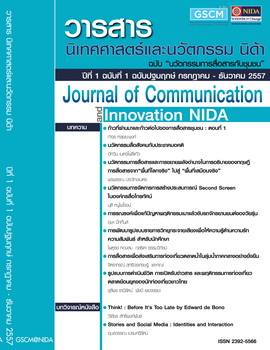นวัตกรรมการจัดการการสร้างประสบการณ์การใช้หน้าจอที่สอง (Second Screen) ในองค์กรสื่อโทรทัศน์
Main Article Content
Abstract
กลยุทธ์การใช้แอ็พพลิเคชั่นหน้าจอที่สอง (Second-Screen Application) ในการสร้างประสบการณ์การใช้หน้าจอที่สอง (Second-Screen Experience) ขององค์กรสื่อโทรทัศน์ เพื่อศึกษาแนวโน้มในการนำมาใช้ในบริบทของประเทศไทย โดยศึกษาจากเอกสารหลักฐานเชิงปฏิบัติขององค์กรสื่อในต่างประเทศประกอบกับทฤษฎีการแพร่กระจายนวัตกรรม ซึ่งผู้เขียนเชื่อว่าการเปลี่ยนแปลงของพฤติกรรมผู้บริโภคที่เป็นผลสืบเนื่องจากการพัฒนาเทคโนโลยีสารสนเทศและการสื่อสาร (ICT) ทำให้อุตสาหกรรมโทรทัศน์ต้องปรับตัว และกลยุทธ์การสร้างประสบการณ์การใช้หน้าจอที่สองก็เป็นวิธีหนึ่งที่น่าจะเป็นประโยชน์ต่อการดำเนินธุรกิจโทรทัศน์ในประเทศไทยในปัจจุบัน แม้ว่าอาจต้องมีการปรับรายละเอียดและกลวิธีการใช้กลยุทธ์บางส่วนเพื่อให้สอดคล้องกับบริบทด้านพฤติกรรมและวัฒนธรรมของผู้บริโภคชาวไทย
ทั้งนี้ ผู้เขียนได้อภิปรายการใช้กลยุทธ์ในด้านประโยชน์ การจัดการ และผลกระทบที่จะเกิดขึ้นกับองค์กรสื่อโทรทัศน์ ผ่านการศึกษาเอกสารและการวิเคราะห์ลักษณะของการจัดการนวัตกรรมทางการสื่อสาร สู่แนวทางการใช้กลยุทธ์การใช้หน้าจอที่สองในการเสริมสร้างความแข็งแกร่งและข้อได้เปรียบให้กับองค์กรสื่อโทรทัศน์ของไทย เพื่อดึงดูดและตรึงความสนใจของผู้ชม รวมทั้งเป็นการตอบรับและตอบสนองพฤติกรรมการใช้หน้าจอที่สองของผู้บริโภคในระหว่างการรับชมรายการโทรทัศน์และในระหว่างโฆษณา ซึ่งจากการที่กลยุทธ์นี้ประสบความสำเร็จอย่างมากในต่างประเทศ จึงน่าจะมีโอกาสที่จะได้รับผลตอบรับที่ดีและเป็นประโยชน์ต่อการดำเนินกิจการของธุรกิจโทรทัศน์ในประเทศไทยได้ด้วยเช่นกัน
This paper discusses the television industry’s use of Second-screen Application Strategy to create the second-screen experience as an opportunity for Thai television industry to recognize and see if it is feasible to apply this strategy in the Thai context. Through document research and analysis of business practices from the countries where the strategy is successfully deployed, together with the theory of diffusion of innovation, I believe that changes in consumer behavior resulting from the development of information and communication technologies (ICT) have caused the Thai television industry to adjust vehemently to these changes, and that the Second-screen Experience is a good strategy that could be beneficial to the television business at the moment – although some modification in certain issues could be made to suit the Thai consumer’s behavior and cultural context.
The paper addresses the second-screen strategy in regards to the benefits, management, tactics, and impacts on television organizations from this strategy, and discusses how the strategy should be deployed to effectively yield the benefits to enhance viewing engagement by creating such experience, while responding to the multi-screen behavior that affects both the on-air programs and advertisements. Chances are that the strategy will accomplish and prosper in Thailand, as it is in other developed countries.
Article Details
ข้อความและความเห็นในวารสารนิเทศศาสตร์และนวัตกรรม นิด้า เป็นของผู้เขียนแต่ละท่าน มิใช่ของคณะนิเทศศาสตร์และนวัตกรรมการจัดการ สถาบันบัณฑิตพัฒนบริหารศาสตร์


